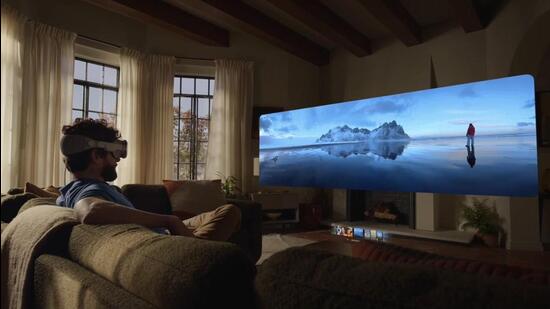AR is a profound technology. Apple CEO Tim Cook said as much. That was the cue for, after many years at an Apple keynote, a ‘one more thing’ segment. Apple WWDC 2023 keynote delivered, on that front too. It was expected Apple will have a take on the augmented reality (AR) space sooner rather than later, and it has done that with some style, with the Apple Vision Pro augmented reality headset. Quite a different approach to AR headsets, nothing the ecosystem has seen so far. First things first, it removes the element of a screen from within the headset.
Still early days, but the use cases being talked about include gaming, entertainment consumption, sports viewing (Formula 1 fans would have noticed Apple demo-ed the F1 TV app) and even productivity. For the latter, this can work with any Apple Magic keyboard or mouse for instance, or you can even invoke your MacBook by simply looking at its screen which then gets transferred into the AR space. If nothing else, the apps will have a virtual keyboard for you to work with.
Also Read: Apple WWDC 2023: What are new features in macOS Sonoma, iPadOS 17, watchOS 10
While speaking of Apple Vision Pro’s utility for the workspace, there is confirmation that Microsoft’s apps including the complete Office suite (that includes Word, Excel, and PowerPoint apps) will be fully compatible with the AR world. As will multiple video-calling apps, including Microsoft Teams, Zoom and Webex. There are more apps coming too, including Disney’s confirmation of their streaming service, for the AR platform.
“It’s the first Apple product you look through, and not at,” said Cook. There’s a reason why. The Apple Vision Pro headset has a glass front, which sits somewhere between transparent and translucent. You don’t have a screen sitting inches from your eyes, and anyone who walks up to the user as they are wearing the headset, can see the eyes of the wearer as they may be speaking with them. This is a tech that Apple has named, Eye Sight.
An extension of that would be the fact that as you immerse in augmented reality content, anyone who approaches the wearer, will be fully visible amidst the virtual content being viewed.
The Apple Vision Pro headset runs the visionOS operating system, which overlays apps and content on the world around you. Apple calls this, the Spatial Computer, purely because of the multi-layered visuals including videos (that can also be shot using the headset) and the audio which tends to give the illusion of direction of a moving source.
There seems to be no need to connect this with an iPhone, iPad, or Mac, to draw on the apps and services. Everything is hosted on visionOS, with complete cross-platform syncing with your other Apple devices.
However, any specifics of storage on the device or the need to add any external storage space for apps and games, will be known in due course.
In terms of the hardware specs, there is an ultra-high-resolution display system in play, which hosts as many as 23 million pixels across two displays, and custom Apple silicon in a unique dual-chip design. That is, the headset will have 64 pixels in the same space that an iPhone’s screen has a single pixel. There are more pixels for each eye, than a 4K television. The computing system needs its own active thermal cooling system too, much like a MacBook Pro. That is alongside an external battery pack, which has a runtime of around 2 hours.
The system is powered by a combination of the M2 chip, which is also seen doing duties on multiple Mac computing devices, alongside a new R1 chip that’ll process the data collected by 12 cameras, five sensors, and six microphones on the headset. Since gaming is in focus quite extensively for the AR space, the R1 has the capability to stream new images to the displays within 12 milliseconds — that is 8x faster than the blink of an eye.
On the headset is a dial, which looks much like the control dial on the AirPods Max headphones, which will allow users to switch between levels of immersiveness – sense of awareness of your surroundings when using apps for work for instance or replicating a dark theatre experience when watching a movie.
What remains to be seen, is if the Apple Vision Pro headset requires any specific level of ambient light illumination (whether it will be susceptible to too much or too little or any specific type of ambient light).
Privacy remains core to the visionOS development. Apple says the OpticID (the authentication system that analyses a user’s iris), the eye tracking information as well as data from the cameras and sensors, all work on device and where required, at a system level. That means third party apps and Apple doesn’t have access to any of a user’s data.
In case you are wondering when you’ll be able to get your hands on the Apple Vision Pro and for how much, there is some element of patience involved. The headset goes on sale in the US early next year, and Apple doesn’t have any specific guidelines at this time. More countries will join in through 2024, though the list isn’t known yet. It’ll be priced at $3,499 (that is around ₹2,88,700) in the US.
For a bit of perspective into the AR ecosystem, the Apple Vision Pro announcement comes just days after Meta announced the next generation Meta Quest 3 headsets – those arrive in fall 2023, with prices starting $499.99 for the 128GB storage option. It is powered by a new Qualcomm Snapdragon chip, increased display resolution and a slimmer design. However, unlike the Apple Vision Pro’s trump card, the Quest headsets isolate a wearer from their ambient world.

